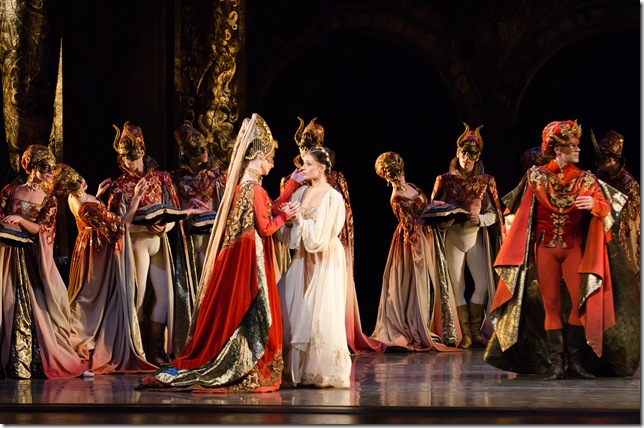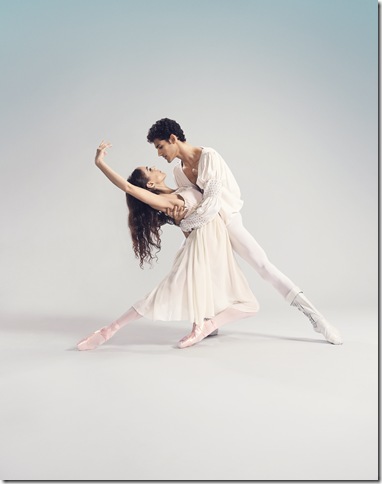By Tara Mitton Catao
Starting its Kravis Center season off last weekend with an ambitious full-length production of John Cranko’s highly regarded Romeo and Juliet, Miami City Ballet continues to present a variety of repertory that not only pleases audiences but also encourages the artistic development of its dancers.
In addition to presenting three different casts as Romeo and Juliet at the Kravis Center performances, company members changed roles within the ballet every night. On Saturday night, it was favorites Patricia Delgado dancing Juliet and Renan Cerdeiro as her Romeo.
There was so much to see, to watch and to hear. The company, led by artistic director Lourdes Lopez, was dancing in full force, the costumes and set were sumptuous, and the Opus One Orchestra, under the inspired baton of Gary Sheldon, played Sergei Prokofiev’s 1936 score with a welling and ebbing that underscored the dramatic action of the ballet and then lingered in your head.
The visuals were equally imposing, all coming together to create a fabulous live painting of the early Italian Renaissance. The set gave enormous height and depth to the stage as it subtly changed and framed the action unfolding in the 12 scenes of the three-act ballet. The somber shades of gray that the set was painted were a terrific background for the lush colors of the opulent fabrics in the clothing of the nobles and citizens of Verona. Both the set and the costumes were designed by Susan Benson and were on loan courtesy of The National Ballet of Canada. The lighting design was by Robert Thomson.
John Cranko established himself as a world-class choreographer when he created this work, his first evening-length ballet. Choreographed in 1962, soon after he became the new artistic director of the young Stuttgart Ballet, Cranko’s dance version of Shakespeare’s tragedy is easy to follow and beautiful to watch.
Dispensing with the standard ballet pantomime and traditional pas de deux steps used in evening-length ballets, Cranko fashioned a new standard with a much more human interpretation. And interestingly, despite the fact that his three-act ballet is quite long, there really is not that much actual dancing, as it relies a great deal on acting.
The story unfolds in an almost cinematic way. There were the lively, bustling marketplace scenes where the young men of the nobles cavorted amongst the peasants and fight among themselves with clashing swords. There was a truly extravagant masked ballroom scene with quadrilles of swirling capes and trailing gowns that swept with authority and seeped with privilege. And there were numerous scenes where the lens closed in on dramatic interchanges and the dancing was very minimal.
Callie Manning was a commanding figure as Juliet’s mother, Lady Capulet, and convincingly displayed a wide dramatic range in her character role while Tricia Albertson gave depth and humor to her role as Juliet’s nurse. Didier Bramaz was a standout in his portrayal of Tybalt with his strong technique and excellent fencing skills which were appropriately grounded and intensely focused.
On first impression, Miami City Ballet’s Romeo and Juliet seemed to have all the necessary ingredients but Saturday evening, it was missing something very essential: believability. Without believability, this ballet became too sparse.
Cranko was a master at building complex dramatic nuances into his choreography, which requires very fine acting, and he fashioned the ballet to start with lush scenes full of movement that later on streamlined and closed in, relying more on acting than dancing for the dramatic final scene.
There were moments where things worked well theatrically but there were more moments that were a little out of balance or a little out of focus. More attention was needed to details. It didn’t help that the clashing swords of the marketplace and thrown daggers in the death scene sounded flimsy and fake in the midst of the volume and depth of the live music.
But what it really needed — what we must truly believe — in order for the story to work was a genuine connection between the two young lovers.
Though dramatically capable and technically clean in the two famous pas de deux, the balcony scene and the bedroom scene, which are the heart of the ballet, Delgado and Cerdeiro as Juliet and Romeo lacked that special chemistry. There wasn’t a sense of intimacy and freshness as they discovered their love for each other. Each was good at his or her own character development but they just didn’t take us all the way. Their love, the kind that one would die for, needed to move me.
I saw Cranko’s artistic muse, the Brazilian-born ballerina Marcia Haydée, dance Juliet with Richard Cragun in the early 1970s and it has been an indelible memory for me ever since. They were magical in their ability to seamlessly fuse extraordinary dance with genuinely believable acting and the chemistry between them was truly there. In the countless moments of running across the stage, they reveled in their love, and in the simple moments of stillness, they changed their lives forever.
Miami City Ballet’s next appears at the Kravis Center in George Balanchine’s staging of The Nutcracker, with seven performances from Dec. 27 to Dec. 30. Call 561-832-7469 or visit www.kravis.org; or, call Miami City Ballet at 305-929-7010 or visit www.miamicityballet.org.


